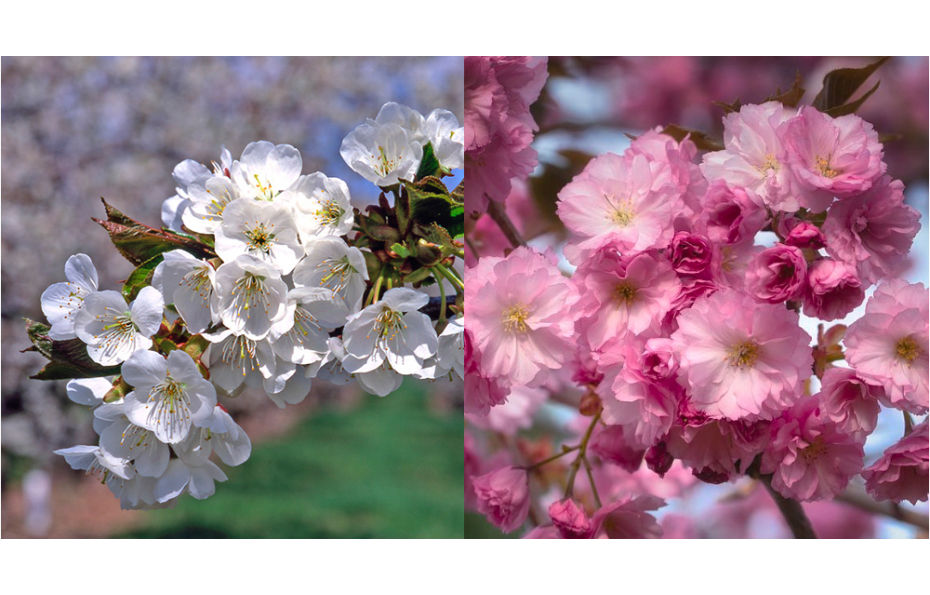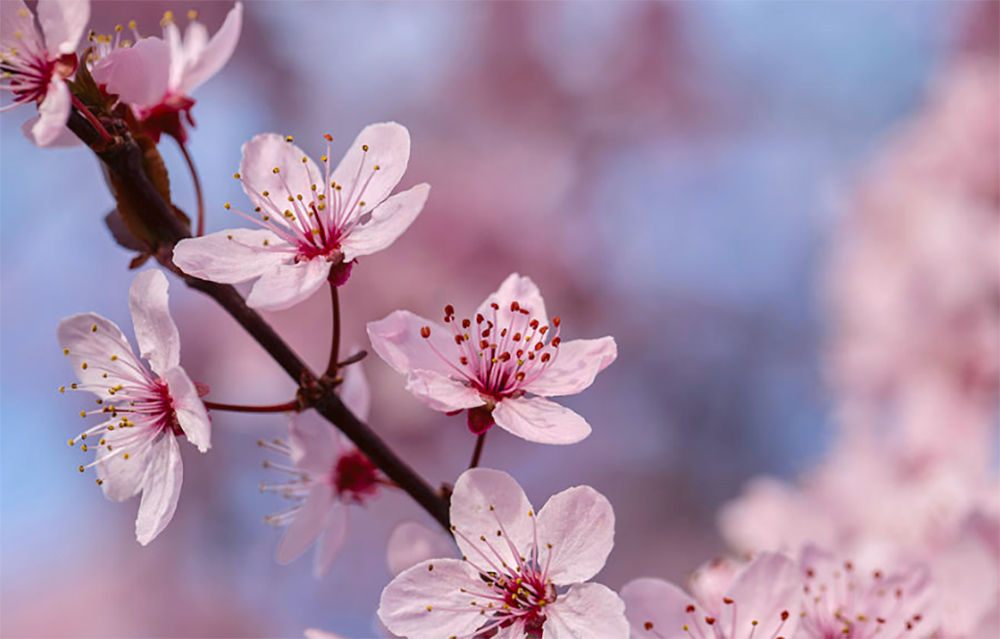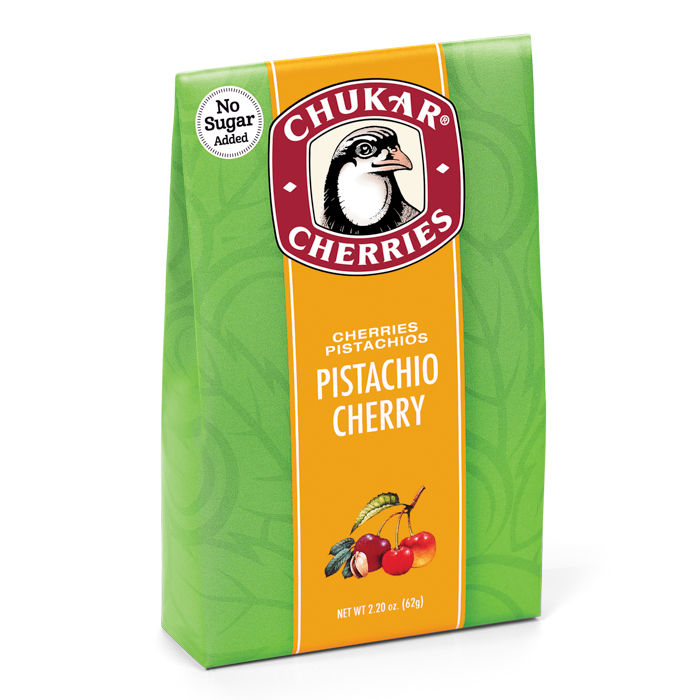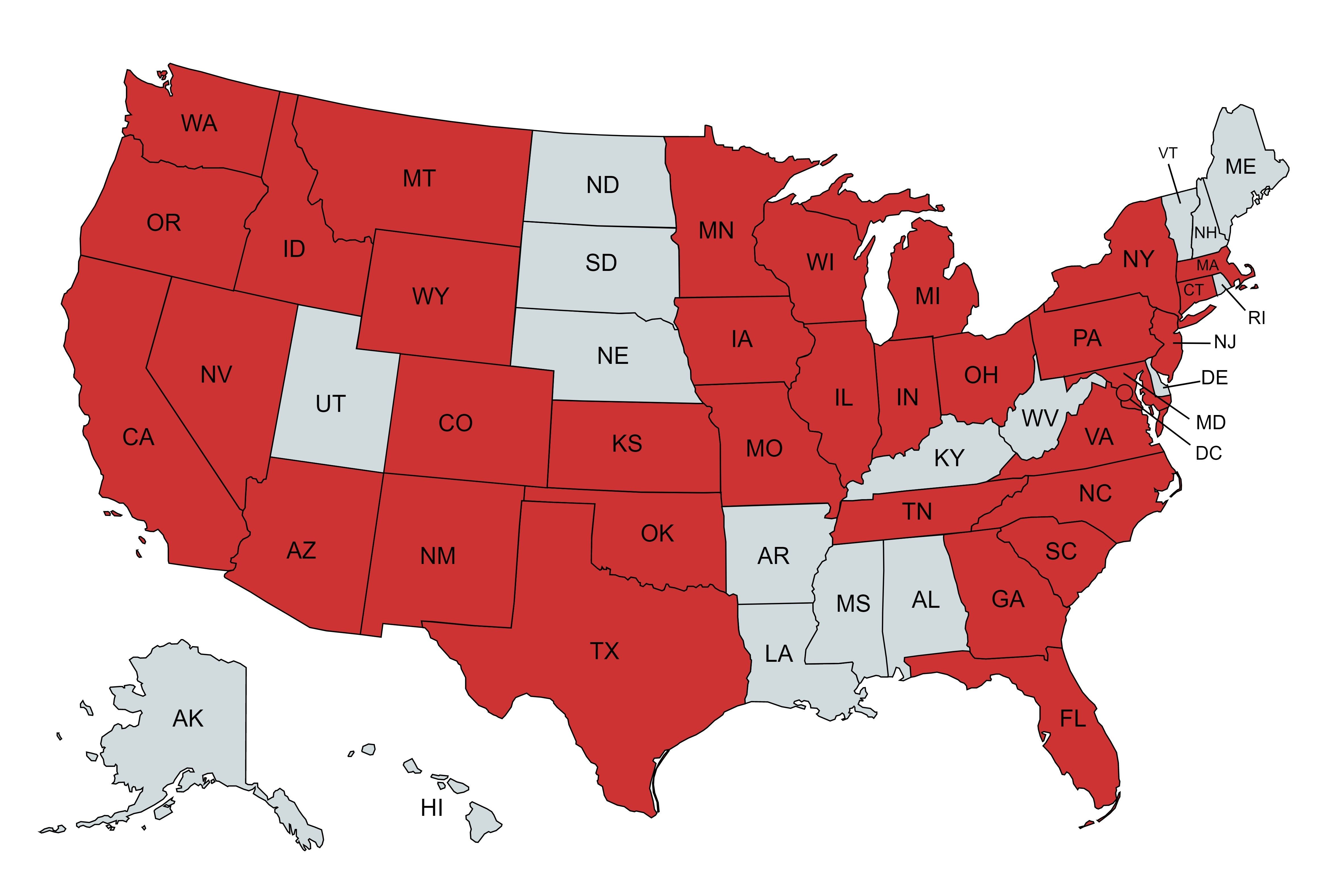Cherry Fruit Trees vs Cherry Blossom Trees
If there were no
cherry blossoms
in this world
How much more tranquil
our hearts would be in spring.
-Ariwara no Narihira
Ariwara no Narihira is one of the best Japanese poets of all time. This hanami quote expresses the fleeting beauty of cherry blossoms and the sense of loss once they disappear—a testimonial to how brief our own lives are.
Cherry fruit trees and ornamental cherry blossom trees are related and share the same genus – Prunus. This genus encompasses other edible fruit trees as well, like plums, peaches, apricots, and almonds. The cherry fruit tree and cherry blossom tree produce similar flowers and fruits, however, cherry fruit trees are cultivated and grown for their tasty fruits, while cherry blossom trees are cultivated and grown for their beautiful flowers. Fruiting trees such as cherries have white blossoms while ornamental trees have pink blossoms.
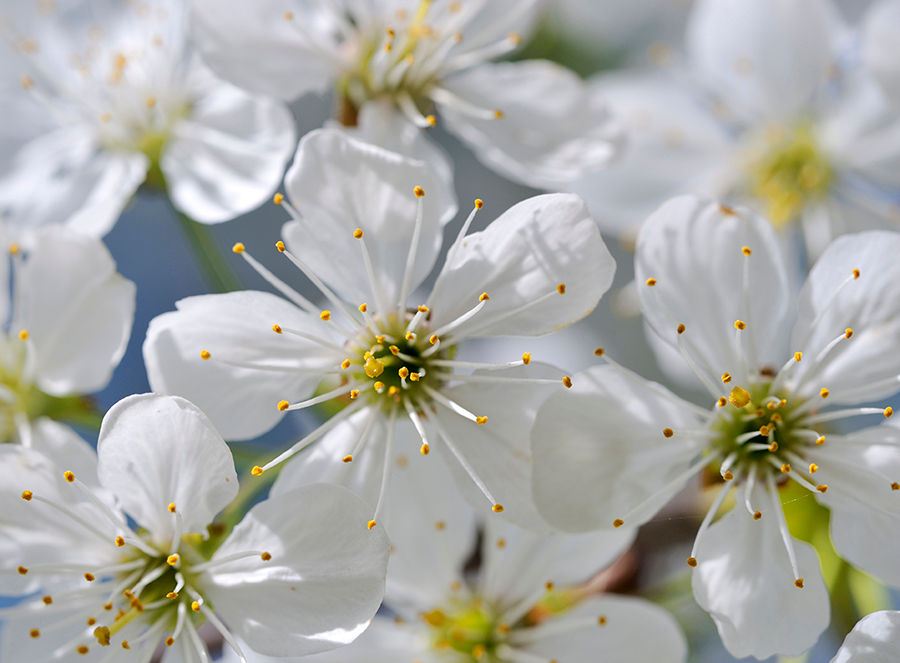
They share a genus, Prunus, yet each one has different varieties and cultivars. For example, sour cherries are Prunus cerasus, sweet cherries are Prunus avium. Cherry blossom trees are made up of many ornamental varieties, like Prunus serrulata or Prunus speciosa. Cherry fruit trees are cultivated and hybridized for their fruits. The focus is on fruitful yield, flavor, disease resistance, and other factors that influence the growth and marketing of edible plants. Trees of the Prunus genus labeled ‘cherry trees’ are cultivated with a focus on producing delicious fruit—less focus on the blossoms.
(photo courtesy of Lynn Hopwood)
The opposite is true for ornamental cherry blossom trees. These trees still produce small fruits, but they are cultivated for their beauty and hybridized to produce the best-looking flowers with the longest blossoming time. At a nursery when purchasing a tree, an easy way to tell the difference is to look at the label. If it is labeled ornamental, it’s a cherry blossom tree. If it’s labeled edible, it’s a cherry fruit tree.
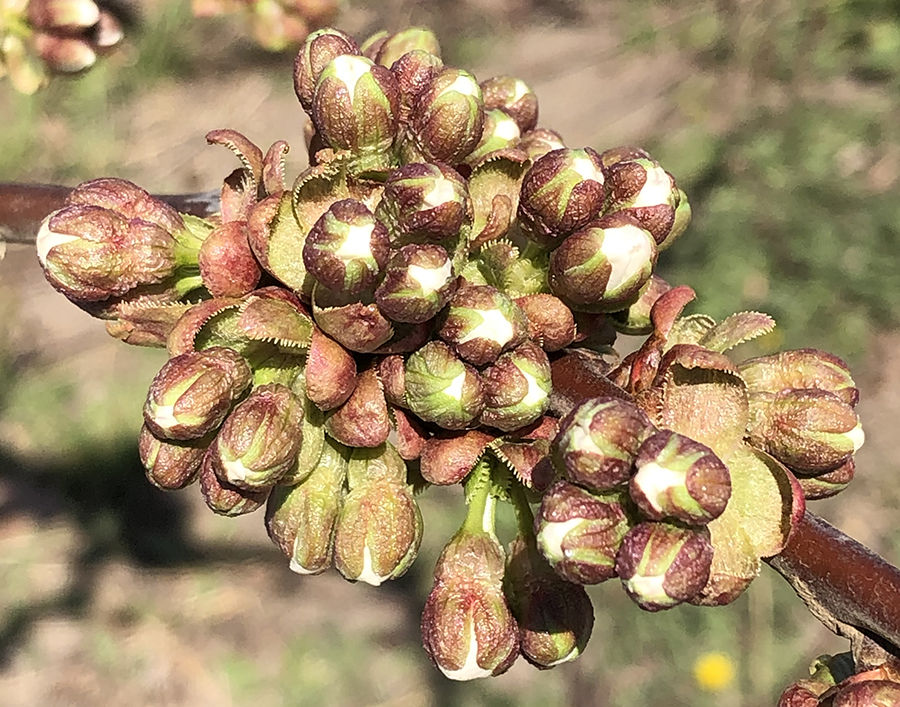 Cherry fruit trees typically grow to be about 15-20 feet tall, while ornamental cherry blossom trees may reach over 30 feet in height. Despite this difference in height, their crown spread is similar, around 20 feet. These trees are easiest to differentiate during the flowering season. During blossom time, cherry fruit trees produce delicate white or blush petals that are relatively short-lived and turn into tiny fruit buds. Over a few months the cherry fruit tree buds will develop into clusters of bluish yellow, bright red, or maroon cherries. To harvest sweet cherries, each cluster is snipped off at the stem using thumb, forefinger, and a quick twist of the wrist—a technique that protects the delicate buds for future harvests. Dark sweet Bing cherries and other dark sweet cherries are place in bins and buckets and take to a nearby packing house for washing and packaging for shipment. Golden Rainier cherries, developed in 1960 in Prosser, Washington are handled with care to reduce bruising, color-picked Japanese style, and placed directly in shippers. To harvest sour cherries, mechanical shakers compel the delicate fruit to fall into broad nets, then quickly placed in hydrocoolers to fully chill before shipping.
Cherry fruit trees typically grow to be about 15-20 feet tall, while ornamental cherry blossom trees may reach over 30 feet in height. Despite this difference in height, their crown spread is similar, around 20 feet. These trees are easiest to differentiate during the flowering season. During blossom time, cherry fruit trees produce delicate white or blush petals that are relatively short-lived and turn into tiny fruit buds. Over a few months the cherry fruit tree buds will develop into clusters of bluish yellow, bright red, or maroon cherries. To harvest sweet cherries, each cluster is snipped off at the stem using thumb, forefinger, and a quick twist of the wrist—a technique that protects the delicate buds for future harvests. Dark sweet Bing cherries and other dark sweet cherries are place in bins and buckets and take to a nearby packing house for washing and packaging for shipment. Golden Rainier cherries, developed in 1960 in Prosser, Washington are handled with care to reduce bruising, color-picked Japanese style, and placed directly in shippers. To harvest sour cherries, mechanical shakers compel the delicate fruit to fall into broad nets, then quickly placed in hydrocoolers to fully chill before shipping.
In contrast, ornamental cherry tree blossoms flower for a few weeks longer and display spectacular bloom variety. Each tree is cultivated to produce the best-looking flowers. In Japan alone, there hundreds of cultivars displaying flowers of many different shapes, colors (even green and yellow–see below), and blossom configurations. For example, Kikuzakura has over 100 petals on a single flower. An easy way to tell the difference between the two when purchasing a tree is to look at the label. If it is labeled ornamental, it’s a cherry blossom tree. If it’s labeled edible, it’s a cherry fruit tree.

Cherry Fruit Trees versus Cherry Blossom Trees— Growing Guidelines
Growing Conditions
Cherry fruit trees and ornamental cherry blossom trees are similar yet different in their growing conditions. Fruit production and growth requires somewhat strict conditions, whereas ornamental trees will still blossom if the conditions are not ideal. Both trees grow in similar mild climates, preferring cool weather to extreme heat. Sweet cherries grow well in USDA Zones 5-8 and sour cherries USDA Zones 3-6. Cherry blossom trees typically grow best in USDA Zones 5-8, matching the zone of sweet cherry fruit trees. That said, climate is more important to consider for cherry fruit trees than cherry blossom trees. To trigger fruiting, cherry fruit trees require periods of cold temperatures for a certain number of hours, the time depends on the variety. It ranges between 400 hours and 900 hours of exposure below 45F to product fruiting. While cherry blossom trees grow in the same USDA zones, there is more leeway in the conditions as the focus is not on the triggering and growth of fruit.

Sunlight
Cherry fruit trees require full sun for most of the day to give the tree enough energy to produce both flowers and fruits. Even planting in in an area that receives partial shade with affect budding and fruiting negatively. In contrast, although full sun is best, cherry blossom trees adapt far better and will still grow and survive in partial shade conditions, producing a stunning display of blossoms.
Soil
Planting both cherry fruit trees and cherry blossom trees require planting in a soil that is acidic but don’t fuss too much about the pH. That said, it’s important to amend the soil with plenty of compost to aid nutrition and water retention. Trees in the Prunus genus, especially cherries, are quite susceptible to root rot. They require well-draining soil. Because different varieties favor slightly different soil types, check with your nursery. Some grow well in clay or sandy soils, while others need the gold standard of loamy, rich soil to thrive. To ensure a strong establishment and healthy growth moving forward, prep the soil to match your tree variety.
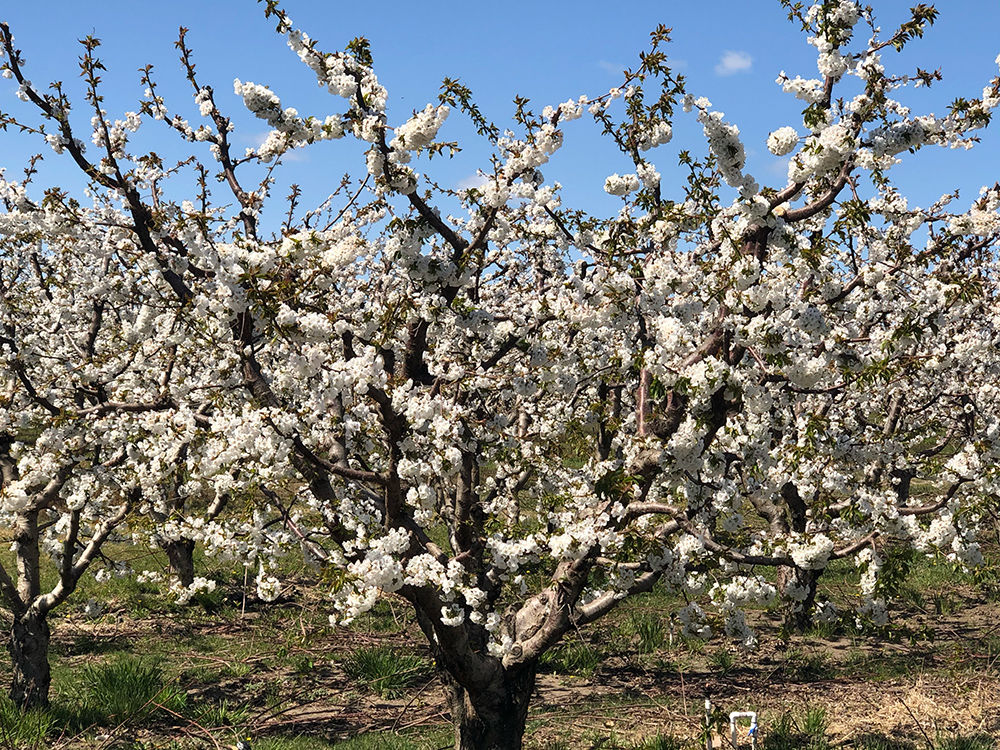
Water
Watering requirements for cherry fruit trees and cherry blossom trees are largely the same. These trees are not particularly thirsty and will normally survive on rainfall alone in higher-than-average rainfall areas. Some varieties are even considered drought-tolerant, needing less water than others. Check your specific variety to determine their water needs. In dryer regions and seasons, they may need an extra deep watering, followed by a dry period. If you live in a drier region, apply a thick layer of mulch around the base of your tree. Straw, leaves, or compost work well and break down into the soil to improve nutrient density over time. The mulch will retain moisture in the soil, limiting your need to water.
Ease of Growth
Neither tree is considered difficult to cultivate or care for, but cherry fruit trees require attention and maintenance to ensure a successful harvest. You need the right climate and enough sun hours to ensure fruiting and the right soil for growth. Secondly, to protect your harvest you need to monitor blossom drop, manage pesky birds, and monitor for other pests like various caterpillars, mites, beetles, and fruit flies that could ruin your harvest or kill the entire tree. Similarly, diseases like leaf spot, canker, or brown rot are quite common but are controllable with consistent monitoring and management. In contrast, cherry blossom trees require less attention. Although pests and diseases are common for ornamental cherry trees, there are greater options and less worry about what products you use.
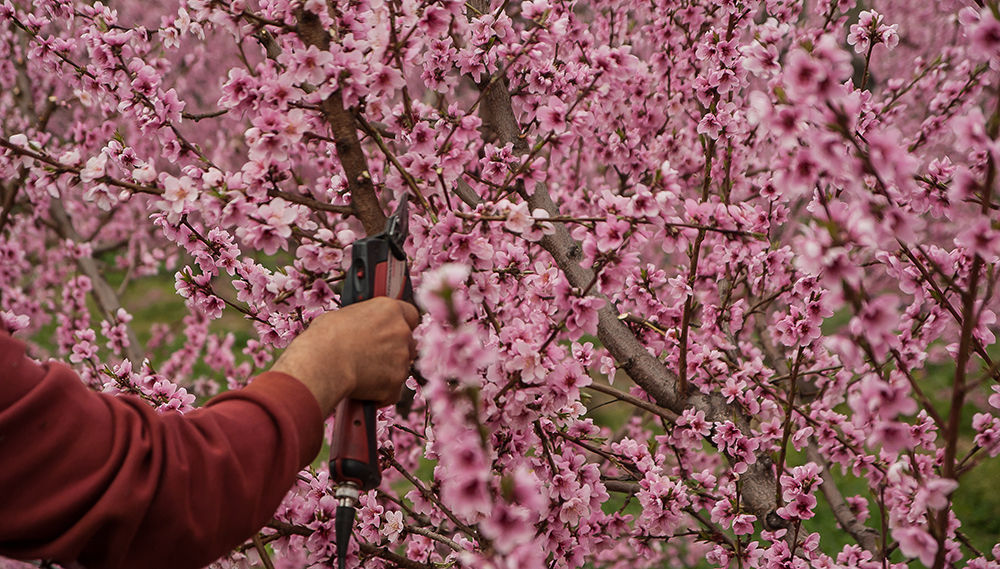
Pruning
For each type of tree be it a cherry fruit tree or ornamental cherry tree, pruning is critical to fruiting or flowering. Cherry fruit trees require a single annual pruning during winter dormancy. Pruning a fruit tree skillfully affects next year’s harvest and future seasons as well. The aim is to open the branches to sunlight to support fruit ripening, protect the potential fruit buds from damage, keep the tree from getting too big too fast. First, take out branches that are growing inward toward the center of the tree or branches that cross or rub against other branches. Towards the top of the tree; thin back a few branches (even larger ones) especially if they shade lower branches. Most pruning can be handled with 3 tools: a hand pruner, a long-handled lopping shears, and a pruning saw. Either bypass or anvil-type pruners can be used, but a bypass is better for the close pruning necessary on young trees.
Pruning cherry blossom trees skillfully is key to sumptuous blossoming. The aim is to determine the architecture of the tree, protection of future blossoms, and opening flowers to sunlight. The trees may be quite tall and pruning varies by cultivar. Check with your nursery and research online.
Life Span
Depending on the variety, climate, growing conditions, pests and diseases, cherry fruit trees are likely to be fruitful around 25 years. With the correct care, cherry blossom trees will live 35 plus years and many much longer. Look to the famous Jindai Zakura, celebrated for blooming for over 2,000 years.


